How to improve your outbound ABM performance with the Reveal Loop (via Plainflow)
Guest post by Leonardo Federico, Founder at Plainflow
Data – especially if it can tell us anything about the habits and preferences of our customers and targets – offers a world of opportunity. But only if we can harness it.
The explosion of data has lead some of the best marketing teams to flip their funnels upside down and directly target the people and companies most likely to buy their products.
This is known as Account Based Marketing (ABM), and can only work with great data.
Today’s customer data is the fuel for tomorrow’s customer experiences.
Fragmented or skewed data leads to fragmented or skewed customer experiences and anyone who wants to be able to impact the customer experience will need to tap into a shared customer data layer and provide the most transparent and up-to-date context on customers at any given moment.
The problem isn’t just the data itself (which is challenging enough to capture and manage), it’s also about how we use today’s technologies to work with and through the data that we have access to.
The proliferation of SaaS that offers software packaged as an API instead of a traditional finished product makes it possible for us to creatively combine a variety of tools to deliver a seamless experience to customers or prospects.
At Segment, former VP of Growth Guillaume Cabane (currently VP of Growth at Drift) demonstrated how to master Account Based Marketing by orchestrating a perfect combination of multiple uncoupled technologies into a single seamless data flow. This approach has allowed Segment to scale automation and provide a personalized customer experience.
The “reveal loop” is an Account Based Marketing tactic implemented by Segment that has proven to move the needle from incremental lifts to real impact (and revenue).
Today, I'll be covering some of more practical aspects of the reveal loop that you can use to support your own implementation. Everything I’ll talk about here can be done without writing a single line of code. Let’s get started.
Implementing the Reveal Loop
What is the reveal loop?
The Reveal Loop ties identification, enrichment, and scoring together into a single data flow. It allows you to create opportunities in your CRM by de-anonymizing your incoming web traffic, capturing company names, scoring those companies, and syncing data in your CRM.
The tech stack composition
Today’s marketing teams need to be able to exploit the strengths of many different products. To create complex scenarios, they use pieces of uncoupled technologies that are extremely efficient at doing just one thing.

For the purposes of this essay, our reveal loop will contain the following ingredients:
- Segment / Plainflow SDKs: To stream all your customer data from your product to Plainflow
- Plainflow: To seamlessly orchestrate different tools and automate journeys via visual if/then branch
- Clearbit Reveal: To de-anonymize your incoming traffic
- Salesforce: To store and save your discovered opportunities using Plainflow's Zapier integration
- Slack: To receive real time alerts
- MadKudu: To know if the company you’re targeting is a viable candidate
The domain problem
When implementing the reveal loop you have to tackle two major problems at the same time: SaaS orchestration and data flow.
Pure SaaS automation platforms like Zapier are great at automating processes and connecting products via APIs, but they don't have shared user profiles that you can tap into to store and retrieve information.
On the other hand, traditional Customer Data Platforms are great for merging and unifying customer data but are not the perfect product to orchestrate different SaaS tools with visual workflows.
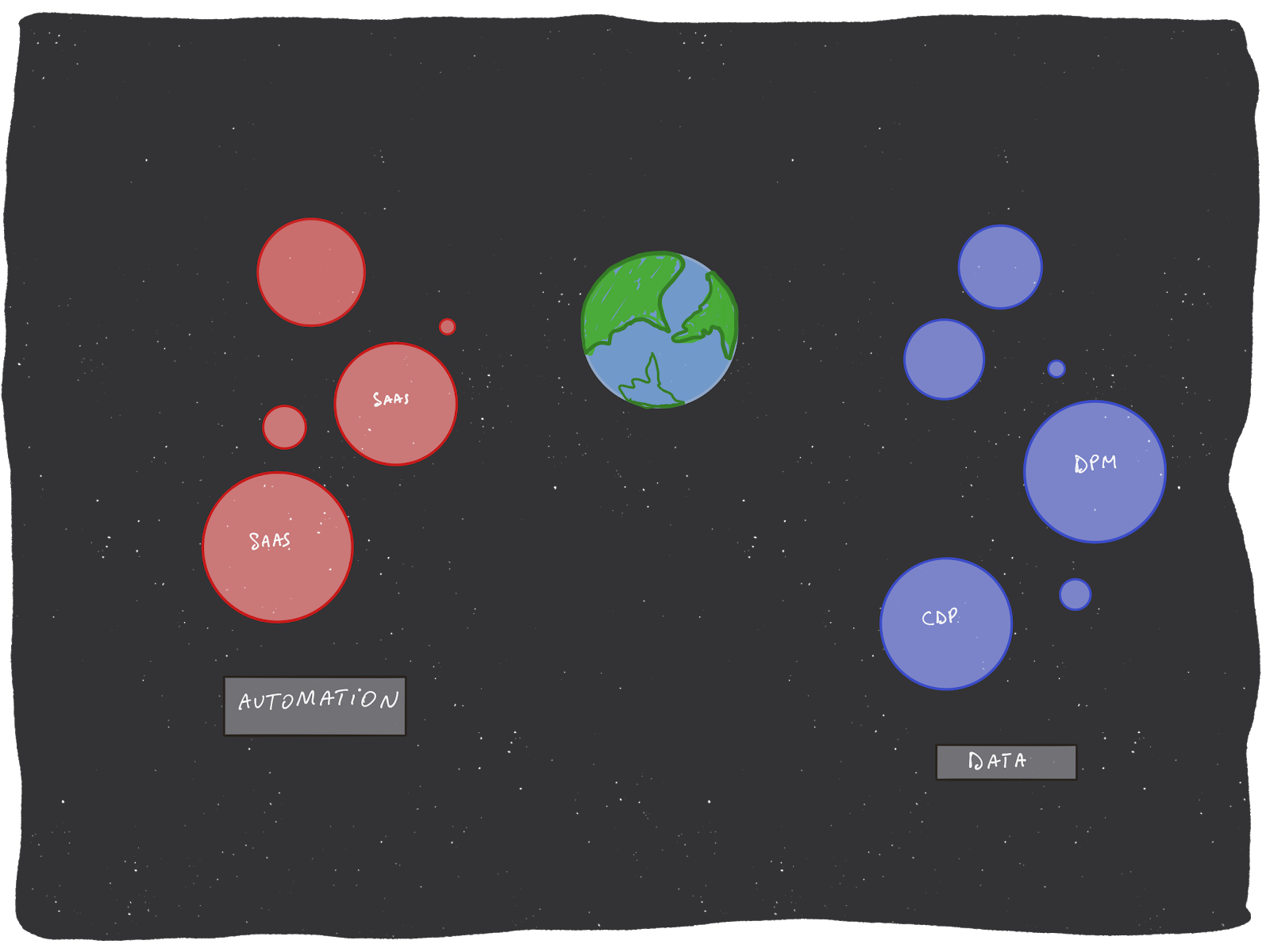
Plainflow (full disclosure: I work here) allows you to address both problems at once. It enables you to centralize your data in a single place and use your customer context at every single step of your workflows.
So... first things first.
You need a way to discern which users have demonstrated an intent to buy your product. They might have clicked on specific pages (your product or marketing pages, for example) or performed specific user events.
Next, you’ll need a way to identify your anonymous users. Here’s where we’ll use Clearbit.
Pure intent is great, but it’s not enough. Once you know who your users are you’ll need a way to understand if they are a good fit for your offering.
Finally, if they’re qualified, you’ll want to start engaging with them as soon as possible.

Set up
- Create a new Plainflow account for free
- Connect your Segment account to Plainflow or install one of the Plainflow SDKs to let data flow from your product
- In one click, connect Plainflow with Clearbit (you’ll be granting access for both Clearbit Reveal and Clearbit Enrichment at once)
- Connect Plainflow with MadKudu
- Connect with Slack to let Plainflow send automated notifications to your channels.
Trigger

Here, we’ll be able to identify the customer actions that indicate an intent to buy.
We’ll start by specifying a “trigger” that represents user intent.
For example:
- Anonymous users who have visited your pricing page twice in the last 7 days
- Anonymous users who have visited your demo request page but didn't fill out the form
- Anonymous users who viewed a specific blog post
Clearbit Reveal
Once you have defined the trigger and the criteria for enrollment, then you’re ready to use the Clearbit Reveal action.
When using the Clearbit Reveal action, Plainflow will automatically pass the IP address tied to the latest pageview for any of the anonymous users that enroll in the workflow. Clearbit Reveal will then convert the IP address into a known domain that identifies the visiting company.
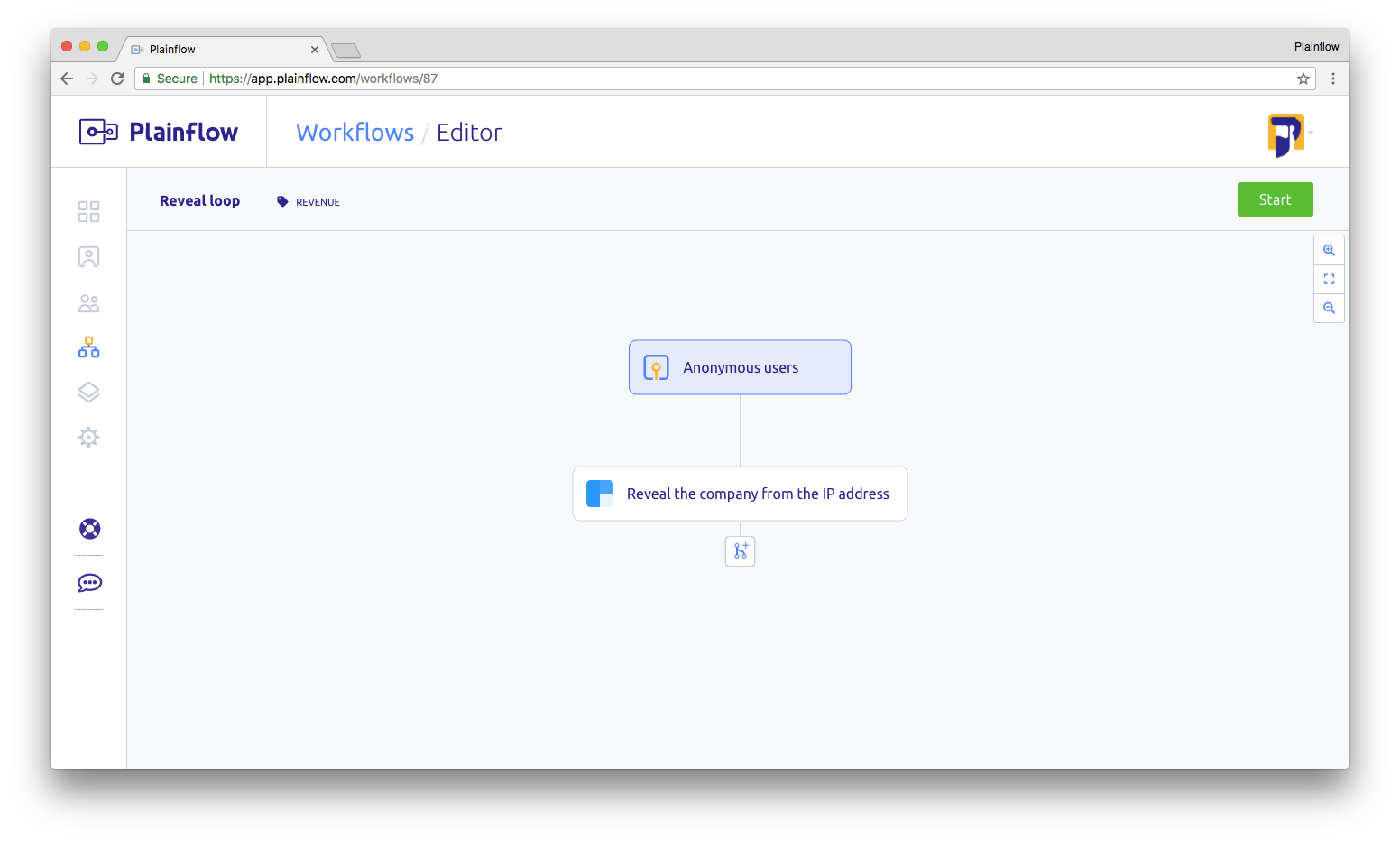
The data payload that Clearbit Reveal APIs will return via Plainflow looks like this:
{
"ip": "87.14.167.142",
"fuzzy": true,
"domain": "segment.com",
"type": "company",
"company": {
"name": "Segment",
"tags": [
"Software",
"SAAS",
"B2B",
"Information Technology & Services",
"Technology",
"Internet"
],
"metrics": {
"alexaUsRank": 14014,
"alexaGlobalRank": 34096,
"employees": 180,
"employeesRange": "51-250",
"raised": 108720000
},
"...": "..."
}
}
The enriched data will be available to you in the context of this workflow and it will be automatically saved and stored by Plainflow in a shared customer data layer. You can tap into this shared data layer at any time to create more precise user segments (e.g. to segment all the anonymous users who visited the pricing page in the last 30 days who work in a company with 1,000+ employees) and to design personalized customer journeys with workflows.
MadKudu
Now that you have revealed the explicit domain of companies who demonstrated an intent to buy, you need an automated way to qualify them. MadKudu does just that for you. Call MadKudu to add a lead score to the domain.

Here’s the data payload that MadKudu will return via Plainflow:
{
"object_type": "company",
"domain": "madkudu.com",
"properties": {
"name": "MadKudu",
"domain": "madkudu.com",
"location": {
"state": "California",
"state_code": "CA",
"country": "United States",
"country_code": "US",
"tags": [
"english_speaking",
"high_gdp_per_capita"
]
},
"number_of_employees": 10,
"industry": "Internet Software & Services",
"customer_fit": {
"segment": "good",
"score": 37,
"top_signals":"..."
}
}
Like any integration that Plainflow supports, the output data will be automatically aggregated and stored.
If condition logic
By selecting the “If” statement, you can create a rule set to define the logic that you want to apply. You can use the results from MadKudu to branch the logic of your workflow. In this way, you want to proceed only if the customer-fit is good or very good.

Send Slack message
You’re now ready to engage with users. To kick this off, you’ll want to notify your Slack #sales room. Plainflow generates an automated message to announce that a highly qualified company has demonstrated interested in buying from you.
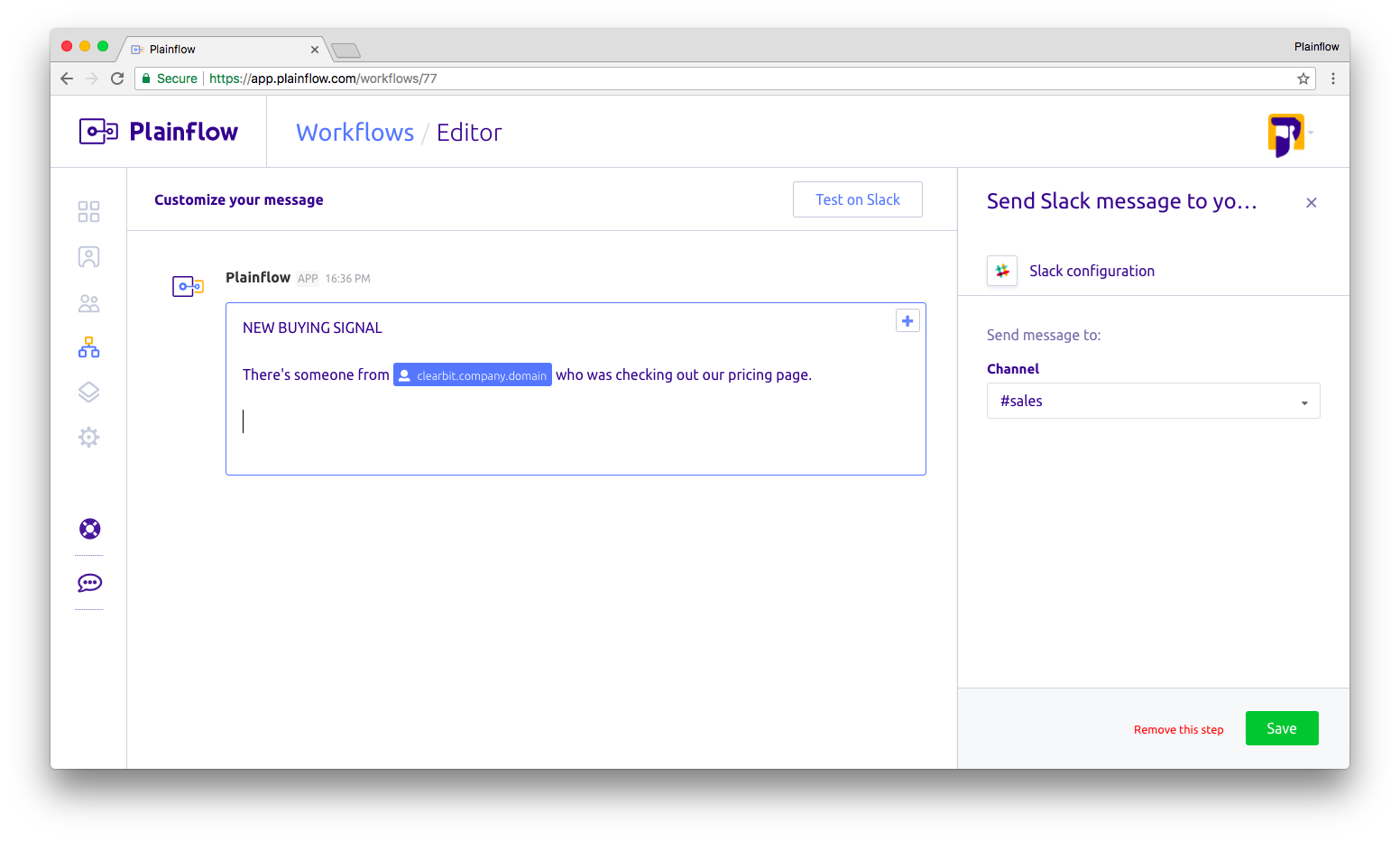
Sync a new opportunity in your CRM
Next, you’ll want to add a new opportunity in your CRM. Since Plainflow is not yet integrated with all of the CRM alternatives, we’d recommend triggering a zap on Zapier to send a new opportunity to your CRM.
 Plainflow will be able to pass all of the user profile information to Zapier via the bundled integration for Zapier. Profile data will then available to use in any of your zaps on Zapier.
Plainflow will be able to pass all of the user profile information to Zapier via the bundled integration for Zapier. Profile data will then available to use in any of your zaps on Zapier.
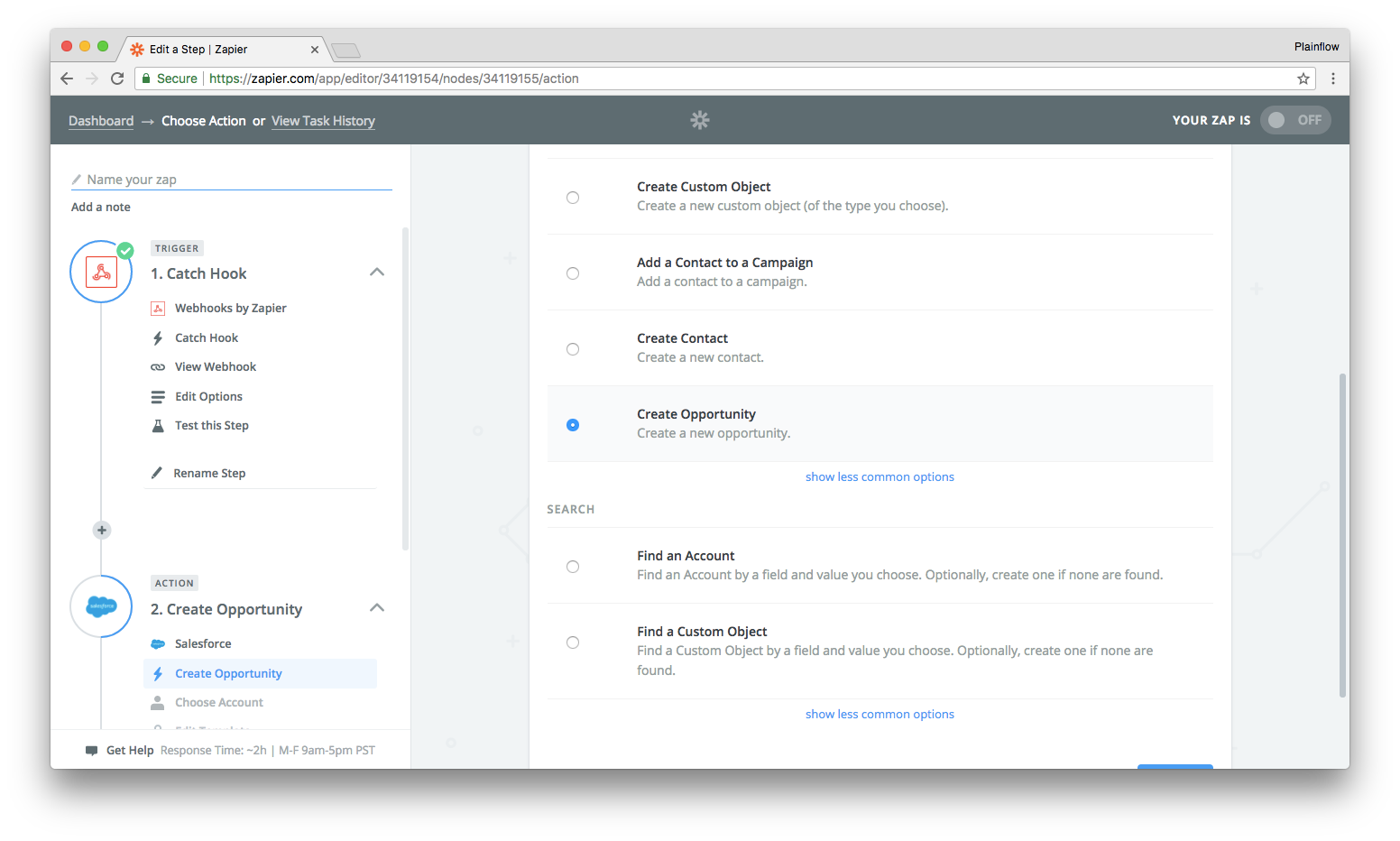 Here’s how the final implementation looks inside Plainflow:
Here’s how the final implementation looks inside Plainflow:
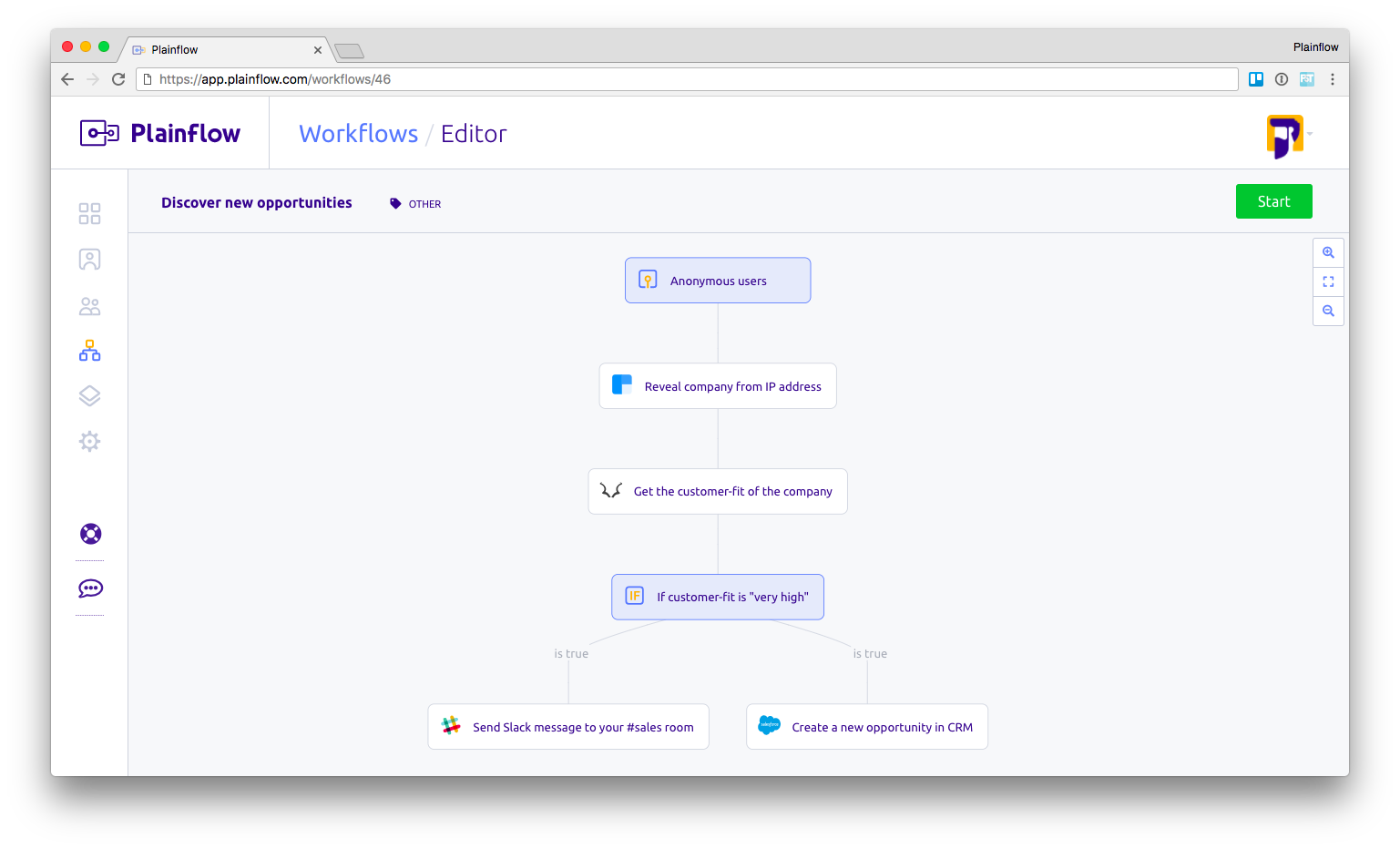
Quick and plain, wasn't it? The Reveal Loop setup is even faster by using the dedicated Plainflow recipe because the full workflow is built for you in just one click.
Plainflow also takes care of these details, out of the box:
- If you are already using Segment, you can easily send Plainflow all your customer data with no engineering effort.
- Anonymous users may be enrolled in your workflow once. You won't have to worry about re-enrolling the same user again.
- Output data from the actions applied in the workflows (MadKudu, Clearbit, etc) will be automatically saved and stored for each user who enrolled in the workflow.
- You’ll be able to apply advanced filters when creating segments of both known customers or anonymous users.
Conclusion
Your ability to understand how new consumer-facing technologies are impacting your business cannot be overstated. For marketers and salespeople on the front lines, the pressure is on to take full advantage of your data, and all the tools in your stack, and use them together for maximum benefit.

